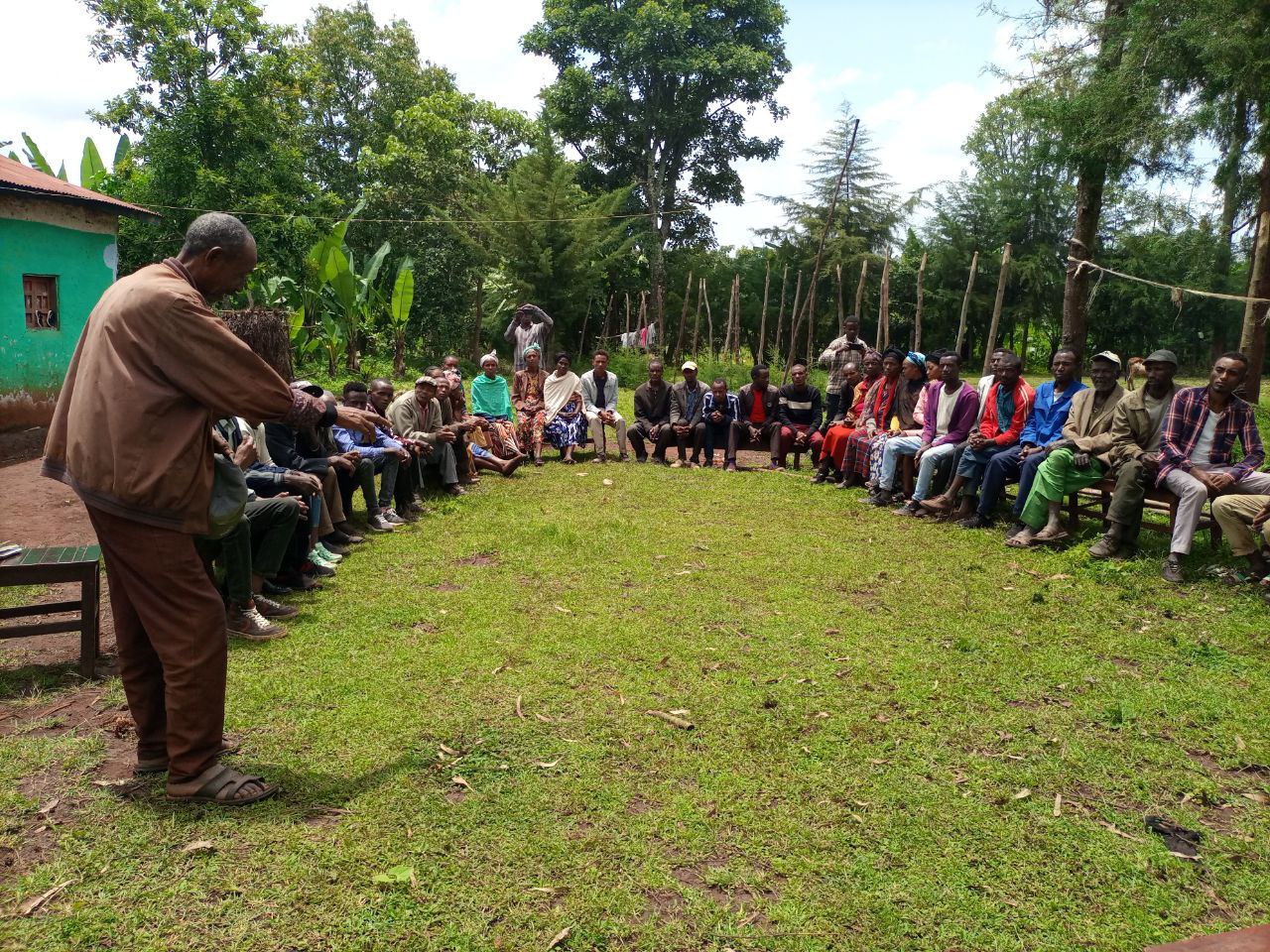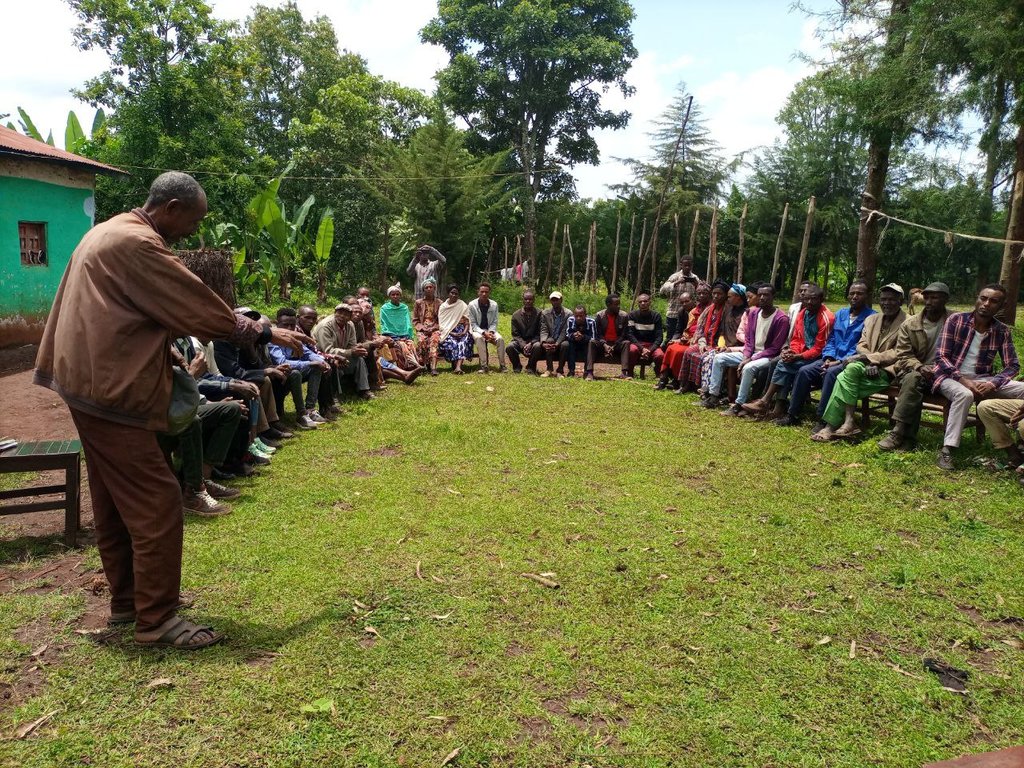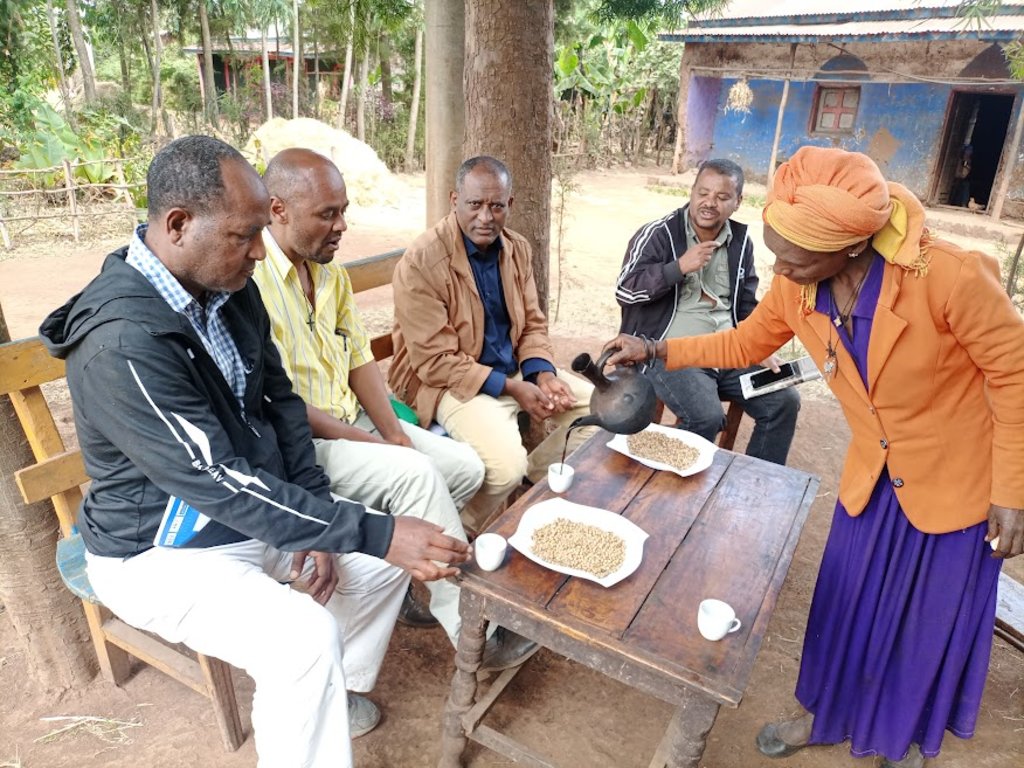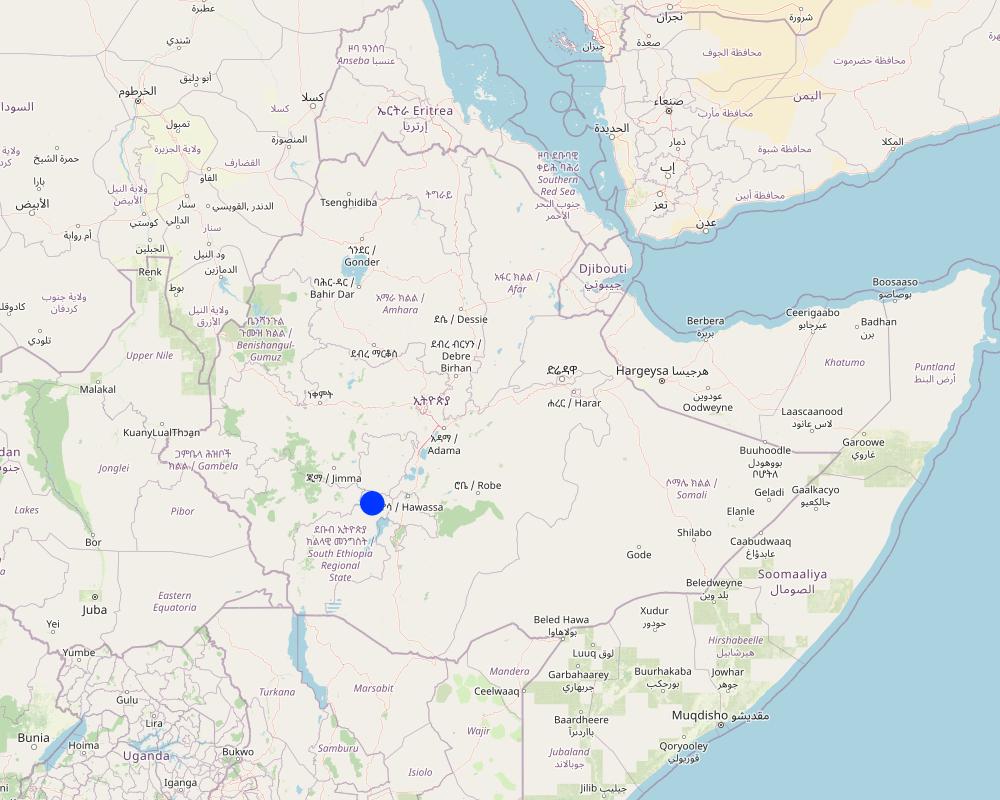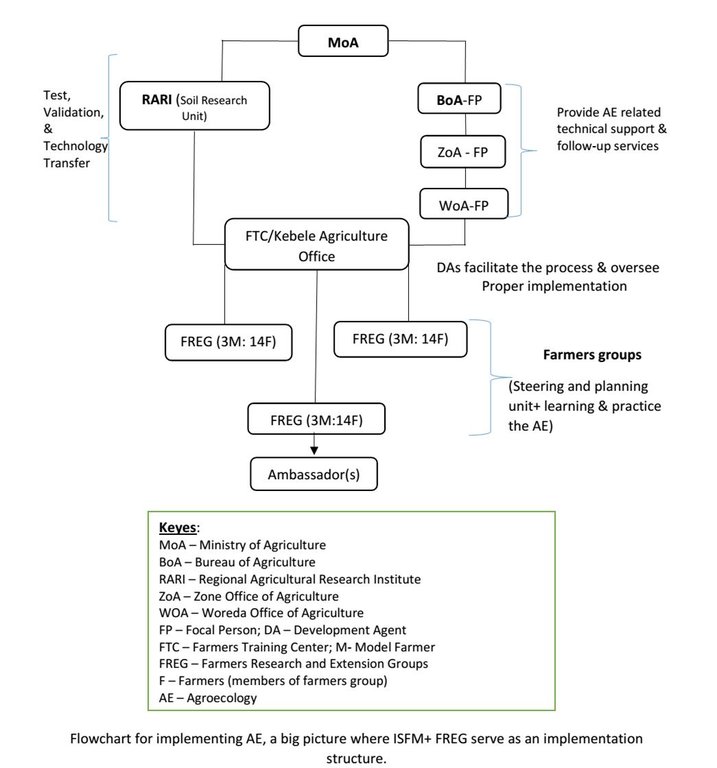Farmers Research and Extension Group (FREG) [埃塞俄比亚]
- 创建:
- 更新:
- 编制者: GERBA LETA
- 编辑者: Julia Doldt, Kidist Yilma, Noel Templer, Tabitha Nekesa, Ahmadou Gaye, Siagbé Golli
- 审查者: William Critchley, Rima Mekdaschi Studer, Sally Bunning
FREG
approaches_6629 - 埃塞俄比亚
查看章节
全部展开 全部收起1. 一般信息
1.2 参与方法评估和文件编制的资源人员和机构的联系方式
关键资源人员
SLM专业人员:
Feleke Temaledegn
+251967693410
temaledgn12@gmail.com
SNNPR Bureau of Agriculture
Hawassa
埃塞俄比亚
有助于对方法进行记录/评估的项目名称(如相关)
Soil protection and rehabilitation for food security (ProSo(i)l)有助于对方法进行记录/评估的机构名称(如相关)
CIAT International Center for Tropical Agriculture (CIAT International Center for Tropical Agriculture) - 肯尼亚1.3 关于使用通过WOCAT记录的数据的条件
(现场)数据是什么时候汇编的?:
16/01/2023
编制者和关键资源人员接受有关使用通过WOCAT记录数据的条件。:
是
1.4 SLM技术问卷的参考
2. SLM方法的描述
2.1 该方法的简要说明
A Farmers Research and Extension Group (FREG) engages about 50 or more farmers in a kebele (lower administrative unit), with three sub groups of 17-20 each who live in a homogenous landscape. It is a local institution established for joint learning, piloting, and evaluating soil improvement technologies across the intervention regions.
2.2 该方法的详细说明
该方法的详细说明:
Farmers Research and Extension Groups (FREGs) are the approach used to test and spread Integrated Soil and Fertility Management (ISFM+)/Agroecology project best practices in Ethiopia. These technologies include livestock urine collection and use, cover crops, intercropping, vermicompost, acid soil treatment by liming, green manures, crop residue management, and bioslurry. A FREG employs a participatory approach, whereby joint investigation and learning is implemented. Farmers' group members use participatory planning and peer learning from one another. The approach is gender inclusive: one-third of the members in a FREG are women. There is also a mix of social categories. FREGs are populated by proactive model farmers who adopt and demonstrate technologies for scaling up. After the first year, the best-performing model farmer serves as an ambassador for knowledge and skills transfer to the indirect beneficiaries.
Collective investigation, learning, adoption, and then promotion of proven technologies are the key features of the approach. Member of the FREG jointly identify soil fertility/acidity-related issues, participate in training and demonstrate the technologies. The ISFM+/ Agroecology projects equip the target groups with implementation skills and knowledge. Site and participant selection are made with participation of woreda and kebele representative partners and the target farmers. Then soil-related issues are jointly identified with the support of laboratory analysis by the Regional Research Institute. This demonstrates that the intervention is implemented by the public research and development actors with technical, financial and/or inputs supply from the projects. The approach tends to mobilize the communities living in similar agroecology and farming systems who are subjected to the same SLM-related issues.
Identifying proactive model farmers and establishing demonstration plots for different technologies and crop types are the basis of collective learning. The demonstration is employed as an experimental and learning plot by showcasing and inspiring farmer groups and indirect beneficiaries in the area. Organizing field days and exchange visits further enables the demonstration of technologies for scaling out. Experience shows that where ISFM+ technologies have been piloted, farmers have built up new agroecology technologies such as cover cropping, intercropping and woodlots development over and above those previously adopted. Target farmers have piloted at least three or more technologies/practices on their plots. The woreda office of agriculture through the assigned project focal person gives closer follow-up for the proper implementation of the technologies. Provision of technical support and advisory service via the development agents (DAs) are among many other services.
2.3 该方法的照片
2.5 采用该方法的国家/地区/地点
国家:
埃塞俄比亚
区域/州/省:
Southern Nations, Nationalities and People Region (SNNPR)
有关地点的进一步说明:
Sodo Zuria district, Kuto-Sarfela kebele
Map
×2.6 该方法的开始和终止日期
注明开始年份:
2022
注释:
The project is expected to go up to the end of 2025.
2.7 方法的类型
- 基于项目/方案
2.8 该方法的主要目的/目标
To promote participatory implementation and peer-to-peer learning by increasing its scope from plot based to landscape scale. The approach capacitates the farmers' group and stimulates the scaling of the approach at a larger scale.
2.9 推动或妨碍实施本办法所适用的技术的条件
社会/文化/宗教规范和价值观
- 启动
Increasing soil degradation, growing infrequent moisture stress, and farmers' willingness to manage their land can be considered enabling factors.
- 阻碍
Giving priority to food crops due to shortage of farmland, climbing traits of the companion/cover crop that may cause harvesting inconvenience if not managed very well.
机构设置
- 启动
The establishment of FREG at local level promotes the implementation of the technology. The involvement of public research and development actors support to implement evidence based and problem solving practices.
参与者的的协作/协调
- 启动
Woreda focal person, development agents, and farmers' group are supporting participatory planning, implementation, and evaluation. The involvement of different actors promotes collaboration and collective action.
法律框架(土地使用权、土地和水使用权)
- 启动
The availability of a legal framework builds farmers' confidence to invest in their land.
政策
- 启动
Support the SLM initiative via the green legacy.
了解SLM,获得技术支持
- 启动
It facilitates effective implementation of technologies/approaches.
工作量、人力资源可用性
- 阻碍
Shortage of labor and costs are hindering appropriate implementation.
3. 相关利益相关者的参与和角色
3.1 该方法涉及的利益相关者及其职责
- 当地土地使用者/当地社区
Members of farmers group
Participate in participatory planning, implementation, and evaluation of the intervention.
- SLM专家/农业顾问
Woreda Natural Resource Management experts or project focal person and development agents.
Facilitate farmers' group meetings during participatory planning, implementation, and participatory evaluation of the activities. Also, provide technical support to the implementers at the various stages of project implementation.
- 地方政府
Kebele administration
Assist in technology scaling up/out via mobilizing the community to learn and adopt from the pilot activities.
- 国家政府(规划者、决策者)
Ministry of Agriculture
Establish an agreement with the project and support it in steering the institutionalization of proven technologies for scaling out via policy support.
- 国际组织
GIZ
Provide financial, technical and material support to the partner organizations and the end users of the project intervention via the public line offices.
3.2 当地土地使用者/当地社区参与该方法的不同阶段
| 当地土地使用者/当地社区的参与 | 指定参与人员并描述活动 | |
|---|---|---|
| 启动/动机 | 互动 | Farmers' group involved in participatory planning, experience exchange visit, and evaluation of the activities. Agricultural experts, development agents, and project staff oversee the implementation of activities and provide technical support/advisory services. |
| 计划 | 互动 | Target farmers and development agents involved in problem identification/assessment and planning. |
| 实施 | 互动 | Farmers who are members of the FREG are involved in implementing the technology with technical support from the woreda focal person and the DAs. |
| 监测/评估 | 互动 |
3.3 流程图(如可用)
具体说明:
Agroecology/ISFM+ implementation flow chart that ran from the Ministry of Agriculture to the local level institution, the FREG. The role of stakeholders at different levels are briefly described in the flow chart.
作者:
Gerba Leta
3.4 有关SLM技术选择的决策
具体说明谁有权决定选择要实施的技术:
- 所有相关参与者,作为参与式方法的一部分
解释:
Land users, SLM experts, Development Agents (DAs), and project advisors play a substantial role in participatory decision-making on the selection of SLM Technologies.
明确做出决策的依据:
- 对充分记录的SLM知识进行评估(基于证据的决策)
- 研究结果
4. 技术支持、能力建设和知识管理
4.1 能力建设/培训
是否为土地使用者/其他利益相关者提供培训?:
是
明确受训人员:
- 土地使用者
- 现场工作人员/顾问
如果相关,请说明性别、年龄、地位、种族等。:
Women-headed households are a member of the three model farmers in the sub-group of FREG. In general, the approach involves women one-third of the group members.
培训形式:
- 在职
- 农民对农民
- 示范区域
- 公开会议
涵盖的主题:
The concepts of agroecology, integrated soil fertility management and overall benefits of cover cropping and related crops such as Desmodium.
注释:
The approach stimulates to conduct farmers group meeting at the beginning of the season as well as for end season evaluation of the pilot technologies.
4.2 咨询服务
土地使用者有权使用咨询服务吗?:
是
指明是否提供了咨询服务:
- 在土地使用者的土地上
- 在固定中心
说明/注释:
The advisory service is face-to-face on demonstration plots at various crop stages including for split application of Urea fertilizer, disease/pest management time, harvesting, and post-harvesting.
4.3 机构强化(组织发展)
是否通过这种方法建立或加强了机构?:
- 是,适度
具体说明机构的强化或建立程度:
- 本地
说明机构、角色和职责、成员等。:
FREG has three model farmers leading the group. They mobilize their followers, demonstrate technologies, and steer collective action. Farmers' groups along with agricultural experts and project staff support the selection of technologies and replacement of the existing ones if the need emerges.
- Facilitation/mobilization
4.4 监测和评估
监测和评估是该方法的一部分吗?:
是
注释:
Participatory monitoring and evaluation are part of the FREG approach. Essentially, beginning and end-season evaluation is the approach employed in the implementation of new technologies.
若是,该文件是否用于监测和评估?:
是
4.5 研究
研究是该方法的一部分吗?
是
明确话题:
- 技术
提供进一步的细节,并指出是谁做的研究:
Research is part of the introduced technologies. Problem identification is the entryway to introducing a new technology/practice. Regional Agricultural Research Institute involves in the assessment and identification of problems, evaluation, and issuance of appropriate recommendations that make the intervention evidence-based.
5. 融资和外部物质支持
5.1 该方法中SLM组成部分的年度预算
如果不知道准确的年度预算,请给出一个范围:
- 2,000-10,000
注释(例如主要的资助来源/主要捐助者):
The budget is generally allocated to support woreda's operational cost and to supply necessary inputs for the implementation of ISFM+ and the Agroecology projects.
5.2 为土地使用者提供财政/物质支援
土地使用者是否获得实施该技术的财政/物质支持?:
否
5.3 对特定投入的补贴(包括劳动力)
- 无
5.4 信用
是否根据SLM活动的方法给予信用值?:
否
5.5 其它激励或手段
是否有其他激励措施或工具用于促进SLM技术的实施?:
是
如果是,请具体说明:
For best-performing farmers, incentives such as solar panels, energy-saving cooking stoves, wheelbarrows, etc., are offered to further motivate the farmers and enable them to properly implement the technology and become a very good advocator for scaling the beneficial practices.
6. 影响分析和结论性陈述
6.1 方法的影响
该方法是否有助于当地土地使用者,提高利益相关者的参与度?:
- 否
- 是,很少
- 是,中等
- 是,支持力度很大
Land users are decision makers on selection of technologies.
这种方法是否有助于基于证据的决策?:
- 否
- 是,很少
- 是,中等
- 是,支持力度很大
Through piloting and learning from the technologies.
该方法是否帮助土地使用者实施和维护SLM技术?:
- 否
- 是,很少
- 是,中等
- 是,支持力度很大
该方法是否提高了SLM的协调性和成本效益?:
- 否
- 是,很少
- 是,中等
- 是,支持力度很大
该方法是否调动/改善了使用财务资源实施SLM的途径?:
- 否
- 是,很少
- 是,中等
- 是,支持力度很大
该方法是否提高了土地使用者实施土地管理的知识和能力?:
- 否
- 是,很少
- 是,中等
- 是,支持力度很大
该方法是否提高了其他利益相关者的知识和能力?:
- 否
- 是,很少
- 是,中等
- 是,支持力度很大
该方法是否建立/加强了机构、利益相关者之间的合作?:
- 否
- 是,很少
- 是,中等
- 是,支持力度很大
该方法是否缓解了冲突?:
- 否
- 是,很少
- 是,中等
- 是,支持力度很大
该方法是否有助于社会和经济弱势群体?:
- 否
- 是,很少
- 是,中等
- 是,支持力度很大
该方法是否改善了性别平等并赋予女性权力?:
- 否
- 是,很少
- 是,中等
- 是,支持力度很大
该方法是否鼓励年轻人/下一代土地使用者参与SLM?:
- 否
- 是,很少
- 是,中等
- 是,支持力度很大
该方法是否改善了阻碍SLM技术实施的土地使用权/用户权问题?:
- 否
- 是,很少
- 是,中等
- 是,支持力度很大
该方法是否改善了粮食安全/改善了营养?:
- 否
- 是,很少
- 是,中等
- 是,支持力度很大
该方法是否改善了市场准入?:
- 否
- 是,很少
- 是,中等
- 是,支持力度很大
该方法是否改善了供水和卫生条件?:
- 否
- 是,很少
- 是,中等
- 是,支持力度很大
该方法是否带来了更可持续的能源使用?:
- 否
- 是,很少
- 是,中等
- 是,支持力度很大
该方法是否提高了土地使用者适应气候变化/极端情况和减轻气候相关灾害的能力?:
- 否
- 是,很少
- 是,中等
- 是,支持力度很大
该方法是否会带来就业、收入机会?:
- 否
- 是,很少
- 是,中等
- 是,支持力度很大
6.2 土地使用者实施SLM的主要动机
- 增加生产
The approach improves farmers' understanding of the benefits of improving soil fertility and soil health, and overall production, and productivity of the soil.
- 增加利润(能力),提高成本效益比
- 减少土地退化
- 环境意识
- 提高SLM知识和技能
6.3 方法活动的可持续性
土地使用者能否维持通过该方法实施的措施(无外部支持的情况下)?:
- 是
若是,请说明如何维持:
The positive outcome of applying the FREG is considered as a payoff for participating farmers as it gave them the energy to sustain the adopted practices. The outputs of integrating technologies, collective learning, and action allow to see significant yield increment per unit of land, improved soil fertility and soil health, etc.
6.4 该方法的长处/优点
| 土地使用者眼中的长处/优势/机会 |
|---|
| Increases farmers understanding of SLM and enables to improve soil fertility and soil health. |
| Allows direct and indirect beneficiaries to adopt beneficial agricultural practices. |
| Promote peer learning to apply technologies that nurture soil fertility and increase crop production and productivity, supply feed to the livestock, manage pests... |
| 编制者或其他关键资源人员认为的长处/优势/机会 |
|---|
| Ensure stakeholders' participation and allows the development of a sense of ownership of the technology. |
| Promote knowledge sharing for scaling out of the technologies. |
6.5 该方法的弱点/缺点以及克服它们的方法
| 土地使用者认为的弱点/缺点/风险 | 如何克服它们? |
|---|---|
| The farmers' group meeting is not so strong and there are absentees or dropouts because of the overlaps with other regular and casual meetings, and private chores. | Strengthening appropriate participation in planning, implementation, collective learning and action process. |
| 编制者或其他关键资源人员认为的弱点/缺点/风险 | 如何克服它们? |
|---|---|
| Lower level of farmers' commitment and non-zealous to bring change with positive impacts. | Need regular follow-up and continuous awareness creation exercises. |
| Take the project intervention for granted | Mainstreaming further land-related issues and the necessity of adopting ISFM and agroecology practices to ensure the sustainability of the management intervention. |
7. 参考和链接
7.1 方法/信息来源
- 实地考察、实地调查
Operational field visited.
- 与土地使用者的访谈
Interview and discussion made with a land user.
- 与SLM专业人员/专家的访谈
A regional expert, project focal person, and regional advisor were consulted.
7.2 参考可用出版物
标题、作者、年份、ISBN:
Agricultural extension approach: evidence from an Integrated Soil Fertility Management project in Ethiopia. Leta, G., Schulz, S., Alemu, G. 2020. DOI: 10.15302/J-FASE-2020331
可以从哪里获得?成本如何?
https://www.researchgate.net (Free online)
标题、作者、年份、ISBN:
Evaluation of Farmer Research Extension Group as Extension Approach: The experience of Sida-Amhara Rural Development Program in Kalu District of Amhara Region, Ethiopia. Abebe, E. 2008.
可以从哪里获得?成本如何?
https://depot.wur.nl/1129
7.3 链接到网络上可用的相关信息
标题/说明:
Farmer research and extension
URL:
https://www.researchgate.net/publication/5055710_Farmer_research_and_extension
标题/说明:
Basics of cover cropping
URL:
https://organicgrowersschool.org/gardeners/library/basics-of-cover-cropping/
链接和模块
全部展开 全部收起链接
无链接
模块
无模块


